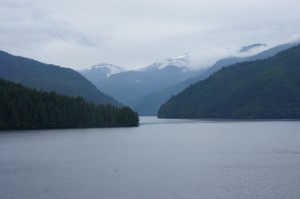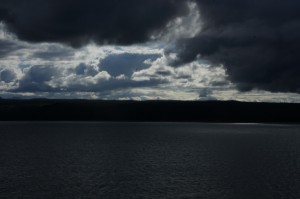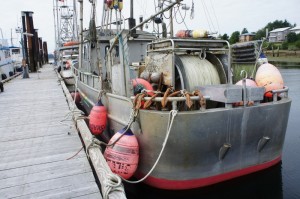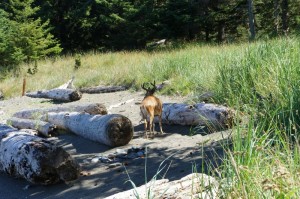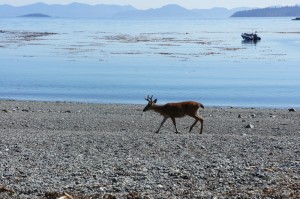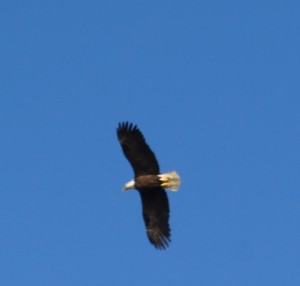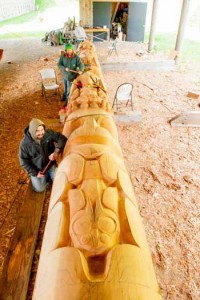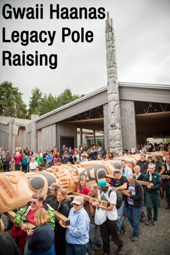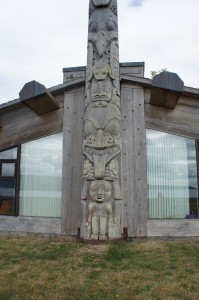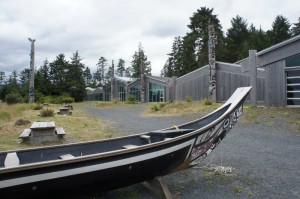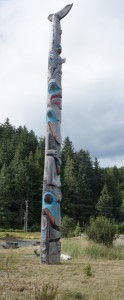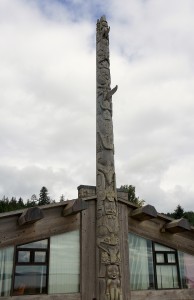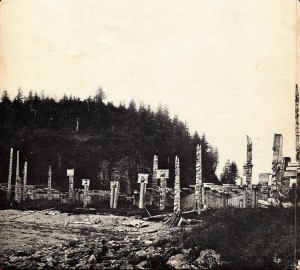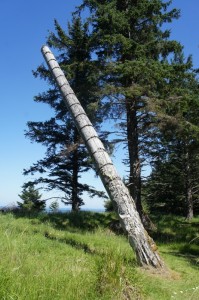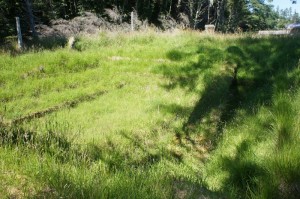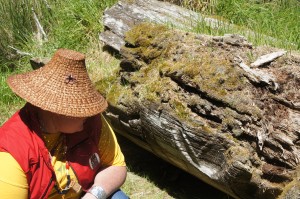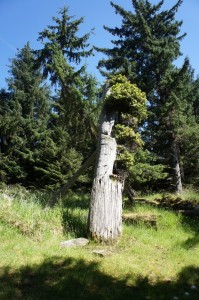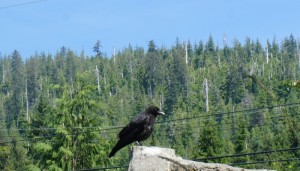Part I Haida Gwaii (Queen Charlotte Islands) Tradition Resurrected
When you visit Haida Gwaii you can feel the magic of 10,000 years of continuous history. Haida Gwaii (formerly Queen Charlotte Islands) is the homeland of the Haida. As you approach on the long ferry rides from Vancouver Island and then Prince Rupert, the mountains descend to the sea steeply, covered with uninterrupted forest; the sky expands; the sea stretches; the clouds dance high and low and the fog sometimes hangs below the mountains, sometimes enveloping us.The sun breaks through clouds of many grays, waters of many blues, greens and silvers. The rain pours out of distant clouds.
We see the flash of salmon leaping, and the incredible grace of huge whales surfacing as they blow out water in a big spray and then dive with their tales sweeping up.
Many eagles fly in the sky, dozens of ravens and crows scavenge on the ground as we arrive.
On the islands we meet people (both First Nation and white) who live off the land, crabbing, fishing (catching the spring salmon or scallops, or halibut or cod), catching deer (introduced of course, along with rats, raccoons, and squirrels) growing vegetables, harvesting berries, just like the ancient Haida.
Along with this basic existence, which is increasingly crucial for survival today, given the expense of living on this remote island, the Haida also have survived by logging, working in canneries, and industrially linked fishing.
But we feel the closeness of the natural world and the human world in the myths, the people intersect with their animals and birds, and they intersect with each other, help each other, and collaborate to confront emergencies. Raven, the trickster, discovered human beings in a large clam shell on the beach, and because he had just gorged himself on the foods of the sea, he coaxed them out and let them flourish. He then intersected with them playing tricks, causing trouble, bungling his greedy ideas, and generally playing with right and wrong.
Eagle swoops from on high to grab small birds and fish, lands on high perches. He stands above us all. Bear is the caretaker animal, who often is seen on poles protecting people and other creatures. Killer Whale (Orca, actually a Dolphin) often is depicted with a human on his back, a woman kidnapped and then later recovered. And of course Raven, the trickster, the most provocative of them all.
All of the stories are part of an oral tradition that has been passed on for centuries and is still being passed on although now there is also a written language (and only 30 fluent speakersexist today). Pansy Colllison, in her book, Haida Eagle Treasures: Tsath Lanas History and Narrative (available to order at the Haida Heritage Center) describes the stories she heard from her grandmother and her mother, as lessons in how to behave. They all have a larger theme of understanding the results of your actions.
Today Haida are closer than ever to their past, as they create a Legacy Pole which is being installed on Windy Bay (Hlk’yah_Gwa_Ga in the Gwaii Haanas National Park Reserve (also a National Marine Conservation Area Reserve and Haida Heritage Site.) It will be broadcast live on August 15. Raising a pole takes a long time and a lot of people, so it will be a 24 hour broadcast.
The Legacy pole celebrates 20 years of cooperation in managing this precious group of islands between the government of British Columbia and the Haida. That agreement was the result of years of Haida resistance actions, starting on Lyell Island in 1985, continuing up to the present.
The Legacy Pole is the first pole installed in this Southern area of the Islands for 130 years.
During those years, the poles of the seven villages on the island which remained until the late 19th century, were removed to various museums, except for the mortuary poles. Some are in the museum near Skidegate, the Haida Gwaii Heritage Center. Since 2001 seven poles visible in the background of the photograph, and three of them below,for each of those villages, have been raised at the Heritage Center
The canoe in the foreground is also a crucial part of the Haida heritage. Some people think they originally came all the way from Polynesia, and according to Pansy Collison, her grandfather paddled all the way to Japan.
The long inhabited villages were forced to be abandoned when their populations were decimated by smallpox introduced by European traders (in some cases intentionally). In addition to smallpox, there was also the period of residential schools, when many children were sent away and stripped of their identity. Christian missionaries also did a lot of purposeful destruction, although today many Haida are Christians. Today the descendants of those ancient peoples live in two villages on Haida Gwaii, Skidegate and Old Masset.
Among the historic villages in Gwaii Haanas, we visited Skedans, a site with beaches on both sides of a spit. Its sheltered mooring was full of bulp kelp, another source of food. At its peak this village had 26 – 30 longhouses 50 pieces of monumental sculpture of which 22 were house frontal poles, 18 single mortuary poles, 3 double mortuary poles, 5 memorial poles, and 5 mortuary figures.
Today we see only a few mortuary poles and indentations in the land where longhouses were located. The continuity of the history and the earth reclaiming its own is deeply moving.
A watchman guide wearing a traditional cedar hat, and a red jacket with the watchmen insignia ( which appears on many poles) takes us through the site pointing out a fallen log that is actually a crouching bear, an eye on the side of a fallen pole with a tree growing out of it, a square indentation is a house where thirty people slept. We see a tall pole with simple indentations that becomes, when explained, a multilayered potlatch hat, one layer for each potlatch, suggesting enormous status and another falling pole with salal actually keeping it from falling apart.
The Haida have survived, as have their stories of Raven, Eagle, Bear and Whale, their songs, their dances, their potlatch tradition. Many of these actually belonged to specific people who died, but who gifted these traditions. While much has been lost, much is being gained, as these ancient traditions intersect with modern ones. Pole carving is one of those lively traditions that is practiced by several master carvers assisted by many others. Robin Wright has just published a book on Northern Haida Master Carvers
This entry was posted on August 13, 2013 and is filed under Art and Activism, Art and Ecology, Art and Politics Now, Uncategorized.

